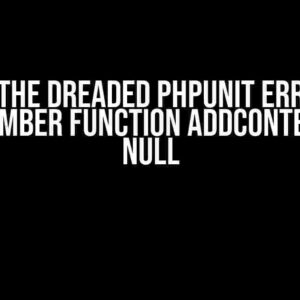Are you tired of using traditional message queues like RabbitMQ or Apache Kafka? Do you want to explore a more lightweight and efficient messaging system? Look no further than NATS! NATS (Native Application Transactional Server) is an open-source messaging system that enables lightweight, scalable, and secure communication between microservices. In this article, we’ll dive into the world of NATS and explore how to connect to a NATS server using PHP.
What is NATS?
NATS is a cloud-native messaging system that enables real-time communication between microservices. It’s designed to be lightweight, scalable, and secure, making it an ideal choice for modern distributed systems. NATS provides a simple and intuitive API, allowing developers to focus on building their applications rather than worrying about the underlying messaging infrastructure.
Why Choose NATS?
So, why should you choose NATS over other messaging systems? Here are a few compelling reasons:
- Lightweight: NATS is incredibly lightweight, with a minimal overhead that won’t bog down your application.
- Scalable: NATS is designed to scale horizontally, making it perfect for modern cloud-native applications.
- Secure: NATS provides built-in security features like authentication and encryption, ensuring your messages are safe and secure.
- Flexible: NATS supports a wide range of programming languages, including PHP, Java, Go, and more.
Setting Up a NATS Server
Before we dive into connecting to a NATS server with PHP, let’s set up a NATS server first. You can install NATS on your local machine or use a cloud-based service like NATS.io.
Option 1: Install NATS Locally
To install NATS locally, you can use the following command:
docker run -p 4222:4222 nats:latestThis will start a NATS server on port 4222 using the official NATS Docker image.
Option 2: Use NATS.io
If you prefer a cloud-based solution, you can sign up for a NATS.io account and create a new NATS cluster. This will provide you with a unique NATS server URL and credentials.
Connecting to a NATS Server with PHP
Now that we have a NATS server up and running, let’s connect to it using PHP. We’ll use the popular PHP NATS client library, nats-io/nats, to establish a connection and publish a message.
Install the NATS Client Library
First, let’s install the NATS client library using Composer:
composer require nats-io/natsEstablish a Connection
Next, let’s create a PHP script that establishes a connection to our NATS server:
<?php
require_once __DIR__ . '/vendor/autoload.php';
.use \NATS\Connection;
.use \NATS\Error;
$serverUrl = 'nats://localhost:4222'; // Replace with your NATS server URL
$connection = new Connection($serverUrl);
try {
$connection->connect();
echo "Connected to NATS server successfully! \n";
} catch (Error $e) {
echo "Error connecting to NATS server: " . $e->getMessage() . "\n";
}
?>In this example, we’re using the Connection class to establish a connection to our NATS server. We’re also catching any errors that might occur during the connection process.
Publish a Message
Now that we’re connected to the NATS server, let’s publish a message to a subject:
<?php
require_once __DIR__ . '/vendor/autoload.php';
.use \NATS\Connection;
.use \NATS\Error;
$serverUrl = 'nats://localhost:4222'; // Replace with your NATS server URL
$connection = new Connection($serverUrl);
try {
$connection->connect();
echo "Connected to NATS server successfully! \n";
$subject = 'my_topic';
$message = 'Hello, NATS!';
$connection->publish($subject, $message);
echo "Published message to $subject: $message \n";
} catch (Error $e) {
echo "Error publishing message: " . $e->getMessage() . "\n";
}
?>In this example, we’re publishing a message to a subject called my_topic using the publish() method.
Subscribe to a Subject
Now that we’ve published a message, let’s subscribe to the same subject and receive the message:
<?php
require_once __DIR__ . '/vendor/autoload.php';
.use \NATS\Connection;
.use \NATS\Error;
$serverUrl = 'nats://localhost:4222'; // Replace with your NATS server URL
$connection = new Connection($serverUrl);
try {
$connection->connect();
echo "Connected to NATS server successfully! \n";
$subject = 'my_topic';
$connection->subscribe($subject, function($message) {
echo "Received message from $subject: " . $message->getBody() . "\n";
});
echo "Subscribed to $subject successfully! \n";
} catch (Error $e) {
echo "Error subscribing to $subject: " . $e->getMessage() . "\n";
}
?>In this example, we’re subscribing to the same subject using the subscribe() method and providing a callback function to handle incoming messages.
Best Practices for Using NATS with PHP
Now that we’ve covered the basics of connecting to a NATS server with PHP, let’s discuss some best practices to keep in mind:
| Best Practice | Description |
|---|---|
| Use Connection Pooling | Use connection pooling to improve performance and reduce the number of connections to the NATS server. |
| Implement Error Handling | Implement robust error handling to handle connection errors, timeouts, and other exceptions. |
| Use Secure Connections | Use secure connections (e.g., TLS) to encrypt messages and protect sensitive data. |
| Monitor NATS Server Performance | Monitor NATS server performance to detect issues and optimize your messaging system. |
Conclusion
In this article, we’ve explored the world of NATS and learned how to connect to a NATS server using PHP. We’ve covered the basics of setting up a NATS server, establishing a connection, publishing messages, and subscribing to subjects. We’ve also discussed best practices for using NATS with PHP, including connection pooling, error handling, and security.
By following this guide, you should now have a solid understanding of how to integrate NATS into your PHP applications. Whether you’re building a real-time messaging system, a microservices architecture, or a scalable cloud-native application, NATS is an excellent choice for your messaging needs.
So, what are you waiting for? Get started with NATS today and unlock the power of real-time communication in your PHP applications!
Looking for more resources on NATS and PHP? Check out the official NATS documentation and the PHP NATS client library on GitHub.
Here are 5 Questions and Answers about “Connecting to a NATS server with PHP” in HTML format:
Frequently Asked Questions
Get the answers to your burning questions about connecting to a NATS server with PHP!
Q1: What is NATS and why do I need it?
NATS (NATS.io) is an open-source messaging system that enables robust and scalable communication between microservices. You need NATS to decouple your application services, increase speed, and improve reliability. With NATS, you can easily integrate your PHP application with other services, ensuring seamless communication and efficient data exchange.
Q2: What is the best PHP library to connect to NATS?
The NATS PHP library is the official and most popular library to connect to NATS from your PHP application. It’s easy to install, configure, and use, providing a simple and intuitive API to publish, subscribe, and receive messages. You can install it via Composer, the PHP package manager.
Q3: How do I establish a connection to NATS from PHP?
To connect to NATS from PHP, you need to create a new instance of the NATS PHP library, providing the URL, port, and any additional connection options. Here’s an example: $nats = new \NATS\Connection('nats://localhost:4222'); Then, you can use the connection object to publish, subscribe, and receive messages.
Q4: How do I publish a message to NATS from PHP?
To publish a message to NATS from PHP, use the publish() method of the connection object, providing the subject (topic) and the message payload. For example: $nats->publish('my.subject', 'Hello, NATS!'); This will send a message to all subscribers of the ‘my.subject’ topic.
Q5: Can I use NATS with PHP frameworks like Laravel or Symfony?
Absolutely! NATS can be easily integrated with popular PHP frameworks like Laravel or Symfony. You can create a NATS service provider or bundle to handle the connection and messaging logic, making it easy to use NATS in your framework-based application. Many community-developed packages and libraries are already available to simplify the integration process.



